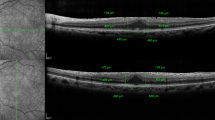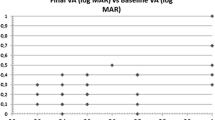Abstract
Purpose
To evaluate the staining characteristics and effect on internal limiting membrane (ILM) histology of two heavier-than-water ILM-specific dyes during macular hole surgery: acid violet 17 combined with 5 % mannitol (AV17-M) and brilliant blue G with 4 % polyethylene glycol (BBG-P).
Methods
Single-centre observational comparative cohort study. The ILM of consecutive patients undergoing surgery for idiopathic macular hole were stained with BBG-P and AV17-M for 10 s each. The ILMs were retrieved and examined with electron microscopy. The extent of retinal and vitreous side debris was scored. Surgical videos were used to assess the staining contrast effect by measuring the Euclidean distance in the CIELAB colour space between stained and unstained retinas after peeling.
Results
51 consecutive patients were studied with 25 in the AV17-M group and 26 in the BBG-P group. The mean age was 71 years with no significant difference between the groups. The amount of retinal side tissue was greater on the BBG-P-stained ILMs compared to the AV17-M-stained ILMs (30.2 versus 19.6 %, p < 0.001). There was a difference in the CIELAB colour space separation distance between stained and peeled retinas (5.89 versus 3.97, p = 0.01) in favour of BBG-P. Visual outcomes between the two groups were similar (logMAR visual acuity 0.40 versus 0.38, p = 0.74).
Conclusion
Both stains were successfully used to peel the ILM with comparable outcomes. AV17-M resulted in less retinal debris than BBG-P, suggesting an altered and potentially beneficial ILM cleavage plane from the retina but with lowered staining contrast than BBG-PEG.



Similar content being viewed by others
References
Nakamura T, Murata T, Hisatomi T et al (2003) Ultrastructure of the vitreoretinal interface following the removal of the internal limiting membrane using indocyanine green. Curr Eye Res 27:395–399
Schumann RG, Gandorfer A, Priglinger SG et al (2009) Vital dyes for macular surgery: a comparative electron microscopy study of the internal limiting membrane. Retina 29:669–676
Haritoglou C, Schumann R, Reiniger I et al (2006) Evaluation of the internal limiting membrane after conventional peeling during macular hole surgery. Retina 26:21–24
Konstantinidis L, Uffer S, Bovey EH (2009) Ultrastructural changes of the internal limiting membrane removed during indocyanine green assisted peeling versus conventional surgery for idiopathic macular epiretinal membrane. Retina 29:380–386
Haritoglou C, Gandorfer A, Gass CA et al (2004) Histology of the vitreoretinal interface after staining of the internal limiting membrane using glucose 5% diluted indocyanine and infracyanine green. Am J Ophthalmol 137:345–348
Haritoglou C, Gandorfer A, Gass CA et al (2002) Indocyanine green-assisted peeling of the internal limiting membrane in macular hole surgery affects visual outcome: a clinicopathologic correlation. Am J Ophthalmol 134:836–841
Gerding H, Timmermann M, Thelen U (2011) Intravital staining of the internal limiting membrane with a novel heavy solution of brilliant blue G. Klin Monatsbl Augenheilkd 228:298–301
Januschowski K, Mueller S, Spitzer MS et al (2012) Investigating the biocompatibility of two new heavy intraocular dyes for vitreoretinal surgery with an isolated perfused vertebrate retina organ culture model and a retinal ganglion cell line. Graefes Arch Clin Exp Ophthalmol 250:533–545
Tura A, Alt A, Haritoglou C et al (2014) Testing the effects of the dye acid violet-17 on retinal function for an intraocular application in vitreo-retinal surgery. Graefes Arch Clin Exp Ophthalmol 252:1927–1937
Cardoso EB, Moraes-Filho M, Rodrigues EB et al (2013) Investigation of the retinal biocompatibility of acid violet for chromovitrectomy. Graefes Arch Clin Exp Ophthalmol 251:1115–1121
Steel DH, Dinah C, Magdi H et al (2014) The staining pattern of brilliant blue G during macular hole surgery: a clinicopathologic study. Invest Ophthalmol Vis Sci 55:5924–5931
http://www.sigmaaldrich.com/catalog/product/aldrich/210579?lang=en®ion=GB Accessed 25/4/15
http://www.alamedics.eu/en/produkte/ophta/dyes/ala-purple.html. Accessed 25/4/15
http://www.dorc.co.uk/products.php?group=18143,18208,18447. Accessed 25/4/15
Broadbent AD (2004) A critical review of the development of the CIE1931 RGB color-matching functions. Color Res Appl 29:267–272
http://en.wikipedia.org/wiki/CIE_1931_color_space. Accessed 25/4/15
Henrich PB, Priglinger SG, Haritoglou C et al (2011) Quantification of contrast recognizability during brilliant blue G- and indocyanine green-assisted chromovitrectomy. Invest Ophthalmol Vis Sci 52:4345–4349
http://en.wikipedia.org/wiki/Color_difference#CIE76 . Accessed 25/4/15
Henrich PB, Valmaggia C, Lang C et al (2014) The price for reduced light toxicity: do endoilluminator spectral filters decrease color contrast during brilliant blue G-assisted chromovitrectomy? Graefes Arch Clin Exp Ophthalmol 252:367–374
Henrich PB, Valmaggia C, Lang C et al (2013) Contrast recognizability during brilliant blue G – and heavier-than-water brilliant blue G-assisted chromovitrectomy: a quantitative analysis. Acta Ophthalmol 91:120–124
Totan Y, Güler E, Gürağaç FB et al (2015) Brilliant blue G assisted macular surgery: the effect of air infusion on contrast recognisability in internal limiting membrane peeling. Br J Ophthalmol 99:75–80
Rodrigues EB, Maia M, Penha FM et al (2013) Staining properties of brilliant blue depending on different incubation times and solvents in humans. Ophthalmologica 230(Suppl 2):68–72
Henrich PB, Priglinger SG, Haritoglou C et al (2013) Quantification of contrast recognizability in sequential epiretinal membrane removal and internal limiting membrane peeling in trypan blue-assisted macular surgery. Retina 33:818–824
Haritoglou C, Mauell S, Benoit M et al (2013) Vital dyes increase the rigidity of the internal limiting membrane. Eye (Lond) 27:1308–1315
Haritoglou C, Mauell S, Schumann RG et al (2013) Increase in lens capsule stiffness caused by vital dyes. J Cataract Refract Surg 39:1749–1752
Kenawy N, Wong D, Stappler T et al (2010) Does the presence of an epiretinal membrane alter the cleavage plane during internal limiting membrane peeling? Ophthalmology 117:320–323
Liu JH, Chen MM, Huang JW et al (2010) Therapeutic effects and mechanisms of action of mannitol during H2O2-induced oxidative stress in human retinal pigment epithelium cells. J Ocul Pharmacol Ther 26:249–257
Awad D, Schrader I, Bartok M et al (2011) Comparative toxicology of trypan blue, brilliant blue G, and their combination together with polyethylene glycol on human pigment epithelial cells. Invest Ophthalmol Vis Sci 52:4085–4090
Costa EF, Barros NM, Coppini LP et al (2013) Effects of light exposure, pH, osmolarity, and solvent on the retinal pigment epithelial toxicity of vital dyes. Am J Ophthalmol 155:705–712
Author information
Authors and Affiliations
Corresponding author
Ethics declarations
Funding
Altomed, Boldon Colliery, UK and Alamedics, Dornstadt, Germany provided financial support by funding some of the research costs.
Conflict of interest
DS declares that he has attended advisory boards, received travel expenses and research funding from Alcon, Fort Worth, USA. KW and AK certify that they have no affiliations with or involvement in any organization or entity with any financial interest, or non-financial interest in the subject matter or materials discussed in this manuscript.
Ethical approval
All procedures were in accordance with the ethical standards of the institutional and/or national research committee and with the 1964 Helsinki Declaration and its later amendments or comparable ethical standards.
Rights and permissions
About this article
Cite this article
Steel, D.H.W., Karimi, A.A. & White, K. An evaluation of two heavier-than-water internal limiting membrane-specific dyes during macular hole surgery. Graefes Arch Clin Exp Ophthalmol 254, 1289–1295 (2016). https://doi.org/10.1007/s00417-015-3193-x
Received:
Revised:
Accepted:
Published:
Issue Date:
DOI: https://doi.org/10.1007/s00417-015-3193-x




